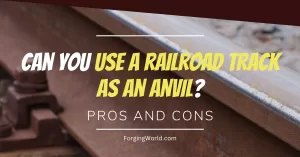Have you ever wondered how you can put those old scraps and discarded materials to good use?
Well, today we’ll be exploring how you can forge with recycled materials and create some fantastic pieces.
So, whether you’re a seasoned pro or just starting your blacksmithing journey, this guide is for you!
Can You Forge with Recycled Materials?
Yes, you can forge with recycled materials like old car parts, leaf springs, railroad spikes, and scrap steel from construction sites. By properly preparing these materials, blacksmiths can create unique, functional, and beautiful forged pieces while saving money and promoting sustainability.
Why Use Recycled Materials?
Recycling materials in blacksmithing has a host of benefits. Not only do you get to save money and reduce waste, but you also contribute to a greener environment.
Plus, repurposing old materials can give your creations a unique and authentic character that new materials can’t replicate.
Choosing the Right Recycled Materials
Not all recycled materials are suitable for forging. To ensure a successful project, you’ll need to pick the right materials. When selecting metals, look for items made from carbon steel, wrought iron, or suitable steel types.
Some popular sources include:
- Old car parts
- Leaf springs from trucks
- Railroad spikes
- Scrap steel from construction sites
- Discarded metal tools
Let’s dive into some popular options and discuss how to identify and select the best materials for your projects.
1. Old Car Parts
Car parts, such as leaf springs, coil springs, and axle shafts, are often made from high-quality carbon steel that’s perfect for forging. To identify suitable car parts:
- Check for visible markings or stamps that indicate the type of steel used.
- Perform a spark test to confirm the material’s carbon content.
- Keep in mind that parts exposed to high stress, like suspension components, might require annealing to relieve internal stresses before forging.
2. Leaf Springs from Trucks
Truck leaf springs are a goldmine for blacksmiths because they’re made from durable, high-carbon steel. They’re excellent for making knives, tools, and other items that require a hard, sharp edge. To work with leaf springs:
- Remove rust and dirt using a wire brush or grinder.
- Cut the springs into manageable sections before heating and forging.
- Be prepared for some trial and error, as different trucks may use varying steel compositions.
3. Railroad Spikes
Railroad spikes are a popular choice for forging knives and other decorative items. High-carbon railroad spikes are ideal, but low-carbon spikes can also be used for non-cutting tools or art pieces. To select the best railroad spikes:
- Look for markings like “HC” (high carbon) or “LC” (low carbon) on the head of the spike.
- Ensure the spike is free from excessive rust or damage that could weaken the final product.
4. Scrap Steel from Construction Sites
Construction sites can be a treasure trove of scrap steel. Rebar, angle iron, and steel beams are just a few examples. When selecting construction scrap:
- Inspect the material for consistent thickness and quality.
- Ensure there are no coatings, such as galvanized steel, which can release toxic fumes when heated.
- Be aware that some construction materials may have a lower carbon content and may not be suitable for all projects.
5. Discarded Metal Tools
Old or broken metal tools like hammers, wrenches, and crowbars can be repurposed into new forged items. To choose the best tools for forging:
- Check for markings indicating the steel type or carbon content.
- Ensure the tool is free from excessive wear or damage that could affect the forging process.
Preparing Your Recycled Materials for Forging
Before diving into your forging projects, it’s essential to prepare your recycled materials properly. This process involves cleaning, removing coatings, and cutting the materials into manageable pieces.
Let’s break down each step to ensure your materials are ready for the forge.
1. Cleaning
Recycled materials often have dirt, rust, and other debris that can affect the forging process and the final product’s quality.
To clean your materials:
- Use a wire brush to scrub off surface dirt and rust. For more stubborn spots, you can use sandpaper or a grinder.
- Consider using a rust converter or a rust remover solution for heavily rusted materials. Follow the manufacturer’s instructions for the best results.
- Rinse the materials with water and dry them thoroughly to prevent further rusting.
2. Removing Paint and Coatings
Paint, protective coatings, and galvanized layers can cause issues during forging, such as toxic fumes or contamination.
To remove these coatings:
- Use a paint stripper or a chemical solvent to dissolve paint and other coatings. Apply the product according to the manufacturer’s guidelines and dispose of it properly.
- Alternatively, use a grinder or a wire brush attachment on a power tool to remove paint and coatings mechanically. Remember to wear appropriate safety gear, such as gloves, goggles, and a dust mask.
- For galvanized steel, soak the material in a vinegar solution for several hours to remove the zinc coating. Ensure the area is well-ventilated to avoid inhaling harmful fumes.
3. Cutting
Cutting your recycled materials into smaller, more manageable pieces will make the forging process more accessible and efficient.
To cut your materials:
- Use a hacksaw for thinner materials and smaller pieces. Ensure you have a suitable blade for cutting metal and that the material is clamped securely.
- For thicker materials or larger pieces, use an angle grinder with a cut-off wheel. Remember to wear proper safety equipment such as gloves, goggles, and ear protection.
- If you have access to a plasma cutter, you can use it for precise, clean cuts on thicker materials. Be sure to follow the manufacturer’s guidelines and safety precautions.
Forging with Recycled Materials
Now that your materials are prepped, you’re ready to start forging!
The process remains mostly the same as working with new materials, but you’ll need to pay extra attention to a few crucial aspects.
- Heating: Recycled materials may have varying compositions, which can affect how they heat up. Monitor the temperature closely, and be prepared to adjust your forge’s fuel accordingly.
- Working the Material: Keep in mind that recycled metals may have different properties than new materials. This variability can affect how they respond to hammering and shaping. Be patient and adjust your technique as needed.
- Quenching: Quenching in water can lead to cracking, especially if the metal has unknown properties. It’s better to use oil to minimize the risk of damage.
A Few Blacksmithing Project Ideas for Recycled Materials
If you’re looking for inspiration, here are some popular projects you can try with recycled materials:
- Bottle openers made from railroad spikes
- Knives or tools forged from leaf springs or car parts
- Decorative pieces using scrap steel or wrought iron
- Hooks, brackets, or other hardware from discarded tools
Final Thoughts
Recycling materials for forging not only helps you save money but also contributes to a more sustainable and eco-friendly approach to blacksmithing.
By choosing the right materials, properly preparing them, and applying your creativity, you can breathe new life into discarded items and create unique, functional, and beautiful forged pieces.
As you embark on your forging journey with recycled materials, remember to maintain a safe workspace and follow blacksmithing safety rules. Don’t be afraid to experiment, learn from your mistakes, and, most importantly, have fun while creating something truly special.
Now that you’re equipped with the knowledge and techniques for forging with recycled materials, it’s time to step into your workshop and begin transforming scrap metal into remarkable works of art.
Happy forging!



